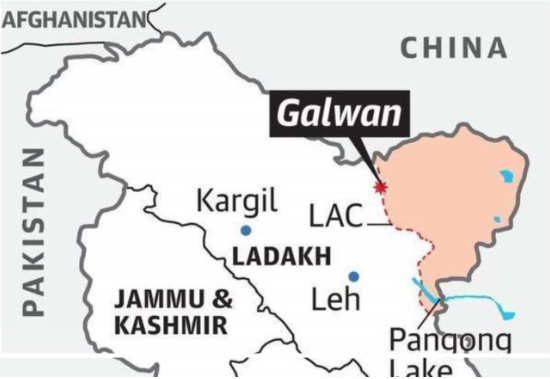The Galwan river was named after Ghulam Rasool Galwan, a Ladakhi adventurer and explorer, who had been part of many European explorations, including two in 1890 and 1896 led by Francis Younghusband , a British explorer and Army officer, who became famous for his role in blocking Russian advances in Tibet.
The valley refers to the land that sits between steep mountains that buffet the Galwan River – The river has its source in Aksai Chin, on China’s side of the LAC, and it flows from the east to Ladakh, where it meets the Shyok river on India’s side of the LAC.
The valley is strategically located between Ladakh in the west and Aksai Chin in the east, which is currently controlled by China as part of its Xinjiang Uyghur Autonomous Region.
At its western end are the Shyok river and the Darbuk-Shyok-Daulet Beg Oldie (DSDBO) road. Its eastern mouth lies not far from China’s vital Xinjiang Tibet road, now called the G219 highway.
The LAC lies east of the confluence of the Galwan and Shyok rivers in the valley,
After the June 15 clash, however, China has claimed the entire valley lies on its side of the LAC
Since early May, China has been objecting to India’s road construction activities at the western end of the valley, in the area between the Galwan-Shyok confluence and the LAC.
Most Chinese maps show most of Galwan river on China’s side of the line, but short of the confluence.
then Premier Zhou Enlai said a 1956 map portrayed the correct alignment. This showed the entire Galwan Valley as a part of India. However, in June 1960 China put out a map claiming sovereignty over the valley
The LAC refers to territory under the effective control of each side, not to their entire territorial claim.
India’s territorial claims extend 38,000 sq km on the other side of the LAC across all of Aksai Chin, but the LAC India observes runs through the valley.
It is true that the LAC has never been demarcated and there are differences in perception of where it lies
According to the 1993 Border Peace and Tranquility Agreement (BPTA), India and China agreed to “strictly respect and observe the LAC between the two sides”.
It also says that “when necessary, the two sides shall jointly check and determine the segments of the line of actual control where they have different views as to its alignment.” Clarifying the LAC has also been explicitly codified in the 1996 agreement on confidence-building measures
incidents at the Pangong lake in Ladakh on May 5 and at Naku La in Sikkim on May 9 had led to injuries, caused by “aggressive behaviour on both sides
The 22nd round of talks between the Special Representatives, National Security Adviser Ajit Doval and China’s State Councillor Wang Yi, was held in Delhi in December 2019. Both “agreed that an early settlement of the boundary question.
The current, and most difficult, stage involves agreeing a framework to resolve the dispute in all sectors. The final step will involve delineating and demarcating the boundary in maps and on the ground.
The 2005 agreement said both sides “shall safeguard due interests of their settled populations in border areas”.
The broader issue appears to be a fundamental difference in how both sides view the boundary question
As one Chinese scholar put it in 2018, “China’s experience indicates that resolving border disputes is usually the result, rather than the cause, of improvement in relations. But India insists that its relations with China won’t improve fundamentally until the border dispute is resolved.
Point 14,The area, from where the Chinese were supposed to withdraw, following a June 6 understanding, is of considerable strategic value.
India’s newly built Darbuk Shyok Daulat Beg Oldie (DSDBO) road, which leads to the base of the legendary 18,176-feet high Karakoram Pass, is within striking distance from the point 14.
In case the Chinese manage to build an observation tower in this area, they can disrupt traffic over an under-construction bridge along the DSDBO road
Traditionally, the Galwan Valley area has been part of the winter trade route that linked Leh with Yarkand and Kashgar across the Karakoram Pass, when frozen rivers allowed caravans to progress towards their destinations.
From Leh, the caravans breached the Ladakh range at Chang La pass, reaching Darbuk, Shyok village on their way to the Karakoram Pass via Daulat Beg Oldie (DBO).
Once the pass was crossed, traders, often in company of monks and scholars, headed for Yarkand and Kashgar, where British India had opened a consulate in a building complex called Chini Bagh.
It entered the Nubra Valley, cutting through the Ladakh range via the 18,600-feet Khardungla Pass and heading to the base of Saser Kangri
Galwan Valley is also not far from Aksai Chin, which is occupied by China. China’s highway number G219 passes through Aksai Chin, which is a vital artery linking the sporadically restive Tibet and Xinjiang, the gateway to Beijing’s ambitious Belt and Road Initiative
The Chinese have long established Heweitan, a 48 km northeast of the LAC as their main base servicing the Galwan Valley posts.
the Chinese have unilaterally expanded their territorial claim line along commanding heights, including the Galwan Valley. In response, India, in mid-1962, established a post opposite Samzungling, an area from where the 80-km-long Galwan river originates before joining the Shyok river, which in turn merges with the Indus.
Chinese troops have fully moved out of the Patrolling Point (PP) 15 of the Hot Springs area in eastern Ladakh as part of the disengagement underway to reduce tensions on the border
Complete disengagement at Pangong Tso area is expected to take time.
Two important issues are raised by intellectuals from India, Why has Status Quo Ante not been insisted on? 2 Why is there no mention of the territorial sovereignty of Galwan valley?”
a Chinese strategic expert cited “historical rights” going back to the Qing Dynasty to claim the entire valley. “Multiple accounts from the Qing Dynasty [1644-1911] and Western literature have recorded that the Galwan Valley was China’s territory.
According to Hemant Adlakha, a professor at JNU’s Centre for Chinese and South East Asian Studies, the change in Chinese thought towards India came after 2017’s Doklam standoff
The Chinese expression used for Doklam was crisis. Today, when they refer to the incident at Galwan, they speak very clearly using terms or phrases like clashes or confrontation
After Doklam, there were several commentaries that China was embarrassed during the crisis asking how could China let the Doklam crisis go on for so long?
China’s long term policies includes, to prevent India from building or repairing roads, especially for the war purposes in Kashmir; two, to expedite construction of the China-Nepal rail-link, and three, to step up building naval and military bases in the Indian Ocean.
China still continue to see the problems on the border as a strategic issue, which can be taken care of politically or diplomatically.

admin
Published: 29 Sep, 2020


0 Comments